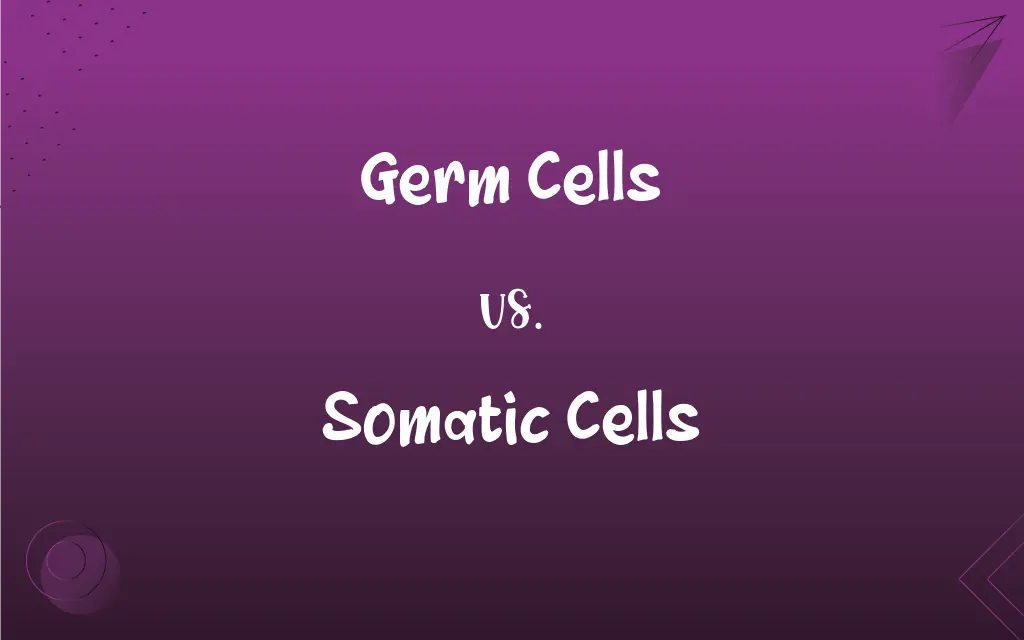Germ Cells vs. Somatic Cells: What's the Difference?
Edited by Aimie Carlson || By Harlon Moss || Updated on October 28, 2023
Germ cells are responsible for reproduction and give rise to gametes, while somatic cells make up most of the body and do not contribute to offspring. They differ in function, structure, and purpose.

Key Differences
Germ cells are specialized cells that are involved in reproduction. They undergo meiosis to produce gametes – the sperm in males and eggs in females. These cells are essential for transmitting genetic information from one generation to the next. Somatic cells, on the other hand, are the cells that constitute the majority of the body, such as those in the skin, muscles, and organs.
Every individual begins as a single cell, which divides and differentiates into various cell types. Germ cells are set apart early in development and are reserved for reproductive purposes. Somatic cells make up the vast majority of an organism's body and have a wide range of functions, from providing structure to processing nutrients.
Genetic mutations that occur in germ cells can be passed on to the next generation, as these are the cells responsible for creating offspring. Mutations in somatic cells, however, will not be inherited by future generations, but they can still have significant implications for the individual, such as in the case of cancer.
The life cycle of germ cells is distinct from that of somatic cells. Germ cells are designed for the long-term storage of genetic information and, after fertilization, kick-starting the development of a new organism. Somatic cells, in contrast, are continually regenerated throughout the life of an organism and are more transient.
Comparison Chart
Function
Reproduction
Make up body tissues and organs
ADVERTISEMENT
Cell Division
Undergo meiosis
Undergo mitosis
Genetic Mutations
Passed to offspring
Not passed to offspring
Chromosomes
Half the number of chromosomes (haploid)
Full set of chromosomes (diploid)
Examples
Sperm and egg cells
Skin, muscle, and nerve cells
Germ Cells and Somatic Cells Definitions
Germ Cells
Cells that undergo meiosis.
Germ cells undergo meiosis to produce gametes with half the number of chromosomes.
ADVERTISEMENT
Somatic Cells
Hold the complete set of chromosomes.
Unlike germ cells, somatic cells have a diploid number of chromosomes.
Germ Cells
They are haploid after meiosis.
After meiosis, germ cells have half the genetic material, ensuring the correct chromosome number after fertilization.
Somatic Cells
Cells that undergo mitosis for replication.
Somatic cells divide by mitosis to repair tissues or facilitate growth.
Germ Cells
Cells involved in reproduction.
Germ cells differentiate to become either sperm or eggs.
Somatic Cells
Cells that form the body of an organism.
Somatic cells make up the tissues and organs in our body.
Germ Cells
Responsible for transmitting genetic information to offspring.
Any mutation in germ cells can be inherited by the next generation.
Somatic Cells
Do not participate in reproduction.
Mutations in somatic cells are not passed down to offspring.
Germ Cells
Found in the reproductive organs.
The ovaries and testes house the germ cells responsible for gamete production.
Somatic Cells
Include all cells except sperm and egg cells.
From skin cells to brain cells, all are categorized as somatic cells.
FAQs
Are germ cells present throughout life?
While the body produces germ cells at different stages, their presence and functionality can decline with age.
What is the primary role of somatic cells?
Somatic cells make up the body's tissues and organs and do not participate in reproduction.
Are genetic mutations in somatic cells inherited?
No, only mutations in germ cells can be passed to offspring.
What are germ cells?
Germ cells are specialized cells involved in reproduction, leading to gametes like sperm and eggs.
Are blood cells considered somatic cells?
Yes, blood cells are a type of somatic cell.
Which cell type is more abundant in the human body?
Somatic cells are more abundant as they make up the majority of the body's cells.
Can somatic cells transform into germ cells?
Under normal conditions, somatic cells do not transform into germ cells.
How many chromosomes do germ cells have after meiosis?
Germ cells have half the number of chromosomes (haploid) after meiosis.
Can germ cells cause diseases?
Abnormalities in germ cells can lead to reproductive issues and, in some cases, diseases like testicular or ovarian cancers.
Why do germ cells undergo meiosis and not mitosis?
Germ cells undergo meiosis to produce gametes with half the genetic material, ensuring proper fertilization.
Can somatic cells repair themselves?
Yes, somatic cells can repair and regenerate through mitosis.
Where are germ cells located?
Germ cells are found in the reproductive organs, such as ovaries and testes.
Are skin cells considered somatic cells?
Yes, skin cells are a type of somatic cell.
Do somatic cells play any role in reproduction?
No, somatic cells do not have a direct role in reproduction.
Are hair cells germ cells or somatic cells?
Hair cells are somatic cells.
What's the significance of germ cells being haploid?
Being haploid ensures that when germ cells combine during fertilization, the resulting embryo has the correct diploid number of chromosomes.
How do germ cells differ in division compared to somatic cells?
Germ cells undergo meiosis, while somatic cells undergo mitosis.
Do somatic cells have a full set of chromosomes?
Yes, somatic cells have a diploid number of chromosomes.
What happens if there's a mutation in germ cells?
Mutations in germ cells can be passed on to the next generation and affect offspring.
Why are germ cells essential for reproduction?
Germ cells give rise to gametes, which carry genetic information to the next generation.
About Author
Written by
Harlon MossHarlon is a seasoned quality moderator and accomplished content writer for Difference Wiki. An alumnus of the prestigious University of California, he earned his degree in Computer Science. Leveraging his academic background, Harlon brings a meticulous and informed perspective to his work, ensuring content accuracy and excellence.
Edited by
Aimie CarlsonAimie Carlson, holding a master's degree in English literature, is a fervent English language enthusiast. She lends her writing talents to Difference Wiki, a prominent website that specializes in comparisons, offering readers insightful analyses that both captivate and inform.































































